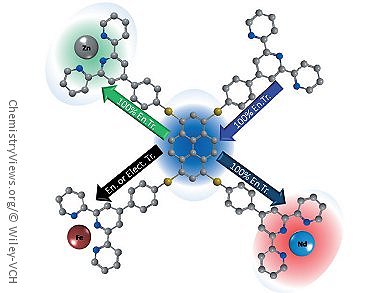Light-harvesting antennae are of great importance for the development of efficient solar cells. Multichromophoric systems capable of harvesting light are of interest as they can be used in multicomponent systems in which the different chromophores are in close contact to favor energy and/or electron transfer, so that the excitation energy can be funneled to a specific acceptor. If one of these chromophores is also a good ligand for metal ions, new interesting properties can arise in a supramolecular system, such as control of the energy/electron transfer processes by changing the metal ion or the ability to generate supramolecular architectures and coordination polymers.
Marc Gingras, Aix-Marseille Université, France, Giacomo Bergamini, University of Bologna, Italy, and co-workers have designed a new multichromophoric system based on a tetra(phenylthio)pyrene core appended with four terpyridine units. The system displays very interesting photophysical properties; in particular, the fluorescence quantum yield is remarkably high (Φ = 0.33) with a lifetime of 1.40 ns. The excitation of the terpyridine units at the periphery leads to quantitative energy transfer to the core.
The pyrene-based system is also shown to form complexes upon addition of iron(II), zinc(II), and neodymium(III) salts. The metal complexes formed “super” oligomeric structures and the assemblies obtained with Nd were also good emitters in the infrared region.
- Synthesis, Characterization, and Metal Ion Coordination of a Multichromophoric Highly Luminescent Polysulfurated Pyrene,
Andrea Fermi, Paola Ceroni, Myriam Roy, Marc Gingras, Giacomo Bergamini,
Chem. Eur. J. 2014.
DOI: 10.1002/chem.201402021



